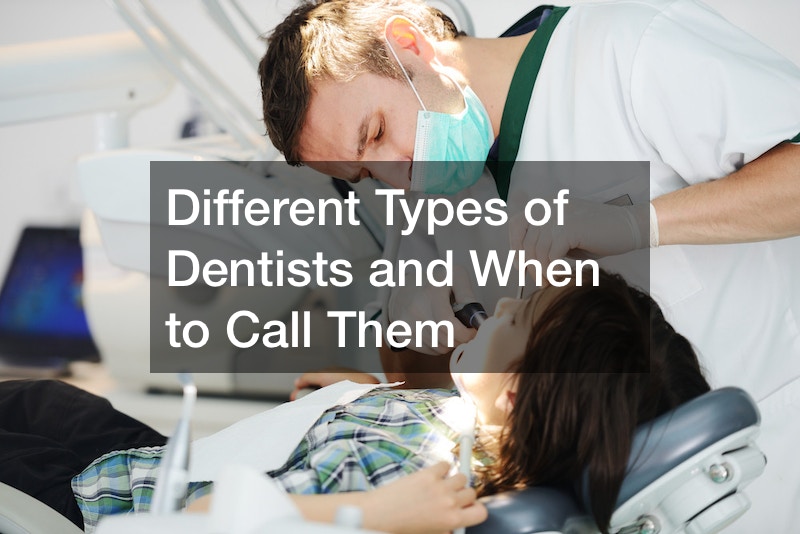
Good oral health is essential to give you a beautiful smile and ensure excellent overall well-being. You must look for dentists with advanced dental knowledge to take good care of your teeth and gums to prevent serious health problems such as endocarditis or even certain types of cancer. Here are the different types of dentists and how they can help you;
General Dentist

A general dentist is an essential oral health care provider because of the many services they provide for patients of all ages. Their major responsibility is to diagnose and treat oral health problems before they become severe. With extensive dental knowledge and experience, general dentists stress preventative treatment. Frequent dental checkups, cleanings, and instructions on good dental hygiene help prevent problems like cavities and gum disease.
Dentists who practice general dentistry are trained to identify and treat various dental problems. They handle the basics like fillings, extractions, crowns, and root canals. General dentists also provide cosmetic dental services, including bonding, veneers, and tooth whitening, to help patients feel more confident about their smiles. Their scope of work includes but is not limited to, referring patients to experts and offering advice on orthodontic assessments.
Checkups with a general dentist twice yearly are recommended to keep teeth and gums healthy. Toothache, cavities, gum disease, and oral trauma require professional dental care. If you wish to improve your smile’s aesthetics and get dental knowledge about the importance of good dental hygiene, consult a general dentist. In addition to that, they play a crucial part in identifying and treating dental problems in their earliest stages, improving people’s general health and quality of life.
Pediatric Dentist
A Pedodontist, or pediatric dentist, is a dentist with additional dental knowledge and experience caring for children, including those with unique dental health requirements. They receive specialized training to address the special needs of pediatric dentistry patients.
It’s recommended that you make the first visit to the pediatric dentist within one year after a child’s birth or six months after the first tooth’s eruption. This early exposure aids in tracking a child’s oral growth and teaches guardians about the importance of healthy habits.
If your child is also experiencing problems with tooth decay, gum disease, or jaw misalignment, a pediatric dentist can help. They cater to children using soft techniques and language that is easy to understand. Finally, preventative therapies like fluoride application and tooth sealants are best applied during regular visits to a pediatric dentist.
Pediatric dentists can promote lifelong dental health by educating both parents and children at an early age. Parental assistance is provided to address practices that negatively affect oral health, and early detection of developmental issues allows for successful correction. Pediatric dentists play a pivotal role from infancy in oral health and a lifelong good outlook on dental care.
Orthodontist

Orthodontic therapy is possible at any age, even old age, and can solve many tooth issues. An orthodontist is a dentist with additional training in diagnosing, preventing, and treating dental and facial abnormalities, especially those involving improper jaw and tooth alignment. They go to specialized post-dental-school programs to hone their skills. Among the many important components of their job is diagnosing a patient’s oral and facial anatomy using examination and imaging techniques like X-rays.
Orthodontists create custom treatment programs such as affordable braces, retainers, and other orthodontic equipment to progressively realign teeth and rectify jaw discrepancies. They actively monitor the treatment’s outcome and adjust orthodontic equipment to keep the teeth and gums in good condition. In addition to improving a patient’s smile, orthodontists can correct bite problems that have a negative effect on speaking, chewing, and the general health of a patient’s mouth.
According to the American Association of Orthodontists, a consultation for orthodontic treatment should begin around the age of seven. Orthodontists can detect misalignment, bite difficulties, and other dental anomalies early on with the help of early consultation. Early consultations help recognize possible concerns and develop strategies for future action, even though treatment does not necessarily begin at this age.
You should call an orthodontist immediately when you realize you have overlapping, twisted, or crowded teeth. Protruding teeth can compromise safety and alter overall appearance. In other cases, the misaligned upper and lower teeth can cause chewing or biting problems, another reason to see an orthodontist.
Other issues that the orthodontist should address include mouth breathing or snoring, which are associated with tooth and jaw anomalies. Finally, an orthodontic assessment may be necessary if you suffer jaw discomfort, pain, or clicking sounds during mouth motions.
Oral Surgeon
To undertake surgical operations involving the mouth, teeth, jaws, and face, you need to see an oral surgeon, sometimes known as an oral and maxillofacial surgeon. These specialists handle cases that go beyond the capabilities of regular dentistry and necessitate surgical intervention.
Oral surgeons perform a wide range of procedures, including the removal of teeth (especially wisdom teeth) and the implantation of dental implants. They also do corrective jaw surgery for issues like misaligned jaws and facial asymmetry and the repair of facial fractures.
Although removal of oral tumors and cysts requires an Ear, Nose, and Throat (ENT) surgeon, reconstructive surgery for oral and facial structures needs oral surgery practice. The oral and maxillofacial surgeon will also repair congenital conditions like cleft lips and palates. They are also conversant in surgical treatments for sleep apnea.
There are a number of conditions in which you are advised to consult an oral surgeon. Among these are managing facial trauma resulting from accidents, diagnosing and treating unusual growths or lesions within the mouth and facial area, and resolving issues related to impacted wisdom teeth that cause pain or discomfort.
Oral surgeons are the go-to doctors for complicated oral and face disorders, while general dentists manage regular dental treatment. If you’re unsure whether you need to see an oral surgeon, your dentist can assist you make that call.
Periodontist

A periodontist is a dentist with advanced dental knowledge and training in detecting, diagnosing, and treating gums, jawbone, and tooth root disorders. These dental specialists have completed higher training beyond dentistry school. You should consult a periodontist for symptoms like bleeding gums, gum recession, or poor breath.
When periodontists discover gum disease, they create individualized treatment programs that may involve extensive cleanings, surgical procedures, and bone transplants. They work with general dentists and other experts to provide the best possible treatment.
Periodontists offer frequent checkups and cleanings to prevent gum disease and remove any hard plaque or tartar a patient may have. Complex situations requiring tooth replacement or cosmetic gum modifications are within their purview because of their mastery of implant dentistry, periodontal surgery, and grafting techniques. In the grand scheme of dental knowledge, periodontists are indispensable in the fight for strong teeth and gums.
Endodontist
Issues relating to the tooth pulp and root canals occur often. They can develop for a number of reasons, including but not limited to tooth decay, trauma, cracks, or recurrent dental treatments on the same tooth. Tooth pulp and root canal issues can’t affect everyone, but they are rather common and may be quite bothersome if they go untreated.
An endodontist is a dentist with advanced dental knowledge to solve myriads of problems related to the dental pulp and the tissues surrounding the tooth roots. Endodontists perform root canal treatments by removing the diseased or damaged pulp, cleaning and sanitizing the inside, and sealing the tooth to prevent further infection.
Root canal therapy is the main treatment that endodontists use to manage pain and prevent tooth loss. They work closely with general dentists and other dental specialists to provide their patients with the most all-encompassing treatment.
If you have significant tooth pain, increased sensitivity to hot and cold, tooth discoloration, swollen gums, or a painful pimple-like lesion on your gums, you should call an endodontist. These signs could indicate an issue with the pulp or the tooth’s roots. In these situations, seeing an endodontist can help you get a proper diagnosis, relieve the pain, and keep your natural teeth intact.
Prosthodontist

A prosthodontist is a type of dentist who has chosen to specialize in reconstructing and repairing damaged or lost teeth and other oral tissues. They’ve gone above and beyond the call of duty to get the specialized dental knowledge necessary to handle the most challenging dental issues. A prosthodontist is the primary doctor for complex dental issues like missing or broken teeth.
It’s time to see a prosthodontist when you lose teeth, suffer extensive dental damage, or encounter cosmetic problems. Implants, bridges, dentures, veneers, and crowns are some options that prosthodontists provide to solve your dental problems. Denture difficulties, TMJ disorders, and complicated bites all need professional hands. Prosthodontists are highly skilled in correcting birth abnormalities and teeth trauma.
A Prosthodontist can provide individualized care to address concerns about the appearance of your smile. While family dentists can provide initial assessments, prosthodontists are trained to handle more complex problems. Consultation with a prosthodontist is necessary to decide the best action for these issues.
Cosmetic Dentist
A cosmetic dentist is a dentist who focuses on improving the aesthetics of their patient’s smiles and teeth. Consult a cosmetic dentist if you want to change how your teeth look. Aesthetic dentistry services include tooth bleaching, veneers to hide flaws, and Invisalign-style invisible braces for discreetly straightening teeth. Cosmetic dentists can use dental bonding to fix chips and cracks, and gum contouring can improve the appearance of a receding gum line.
Complete smile makeovers and extensive treatment regimens can solve several problems at once. Contact a cosmetic dentist with a clear idea of what you hope to accomplish. Although the primary goal of cosmetic dentistry is to improve your smile’s appearance, proper oral hygiene is still essential to the effectiveness of any cosmetic dental operation. After consulting a cosmetic dentist’s dental knowledge to determine the best procedures, you may have a healthier and more confident broad smile.
Emergency Dentist
Dental emergencies demand swift action to manage pain, prevent harm, and safeguard oral health. Examples include severe toothaches, knocked-out teeth, broken teeth, infections, loose teeth, lost fillings or dental crowns, damaged braces, and soft tissue injuries. In such crises, an emergency dentist is essential. They provide urgent care outside regular hours despite employee healthcare plans.
To effectively handle a dental crisis, assess its severity by checking for bleeding, pain, or visible damage. You can control bleeding by applying gentle pressure with clean material. If a tooth is knocked out, handle it by the crown, and consider reinserting it or storing it in milk/saliva. Manage pain with OTC pain relievers (avoid aspirin on gums), and contact an emergency dentist for guidance. It’s recommended that you use intermittent cold compresses to reduce swelling and temporarily cover exposed areas with dental cement or sugar-free gum.
Calling an emergency dentist is necessary for severe pain, trauma resulting in tooth loss or severe breakage, swelling, persistent bleeding, or signs of infection. Timely action can preserve oral health and prevent complications. When in doubt, seeking professional help is crucial.
How to Choose the Right Dentist
Finding a good local dentist requires systematic research. Determine first whether you need general dental care, specialty dental care, or aesthetic dental care. You should also seek advice from someone you know and trust, such as loved ones or medical experts. A well-considered choice often benefits from the speaker’s unique perspective.
Verify the dentist’s experience and training by looking at their credentials. Real-world insights into patient experiences may be gained via online reviews like Google and Yelp. Ask the dentist if they employ cutting-edge equipment and methods, and be sure they provide the necessary treatments.
You can schedule a visit to see the dentist in person and get a sense of how they interact with patients, how comfortable they make you feel, and how eager they are to address your issues. Stop by the family dental offices and have a look around. Think about how close they are to your home or workplace, how flexible their hours are, and whether or not they take your dental insurance.
For optimal oral and general health, it’s essential to have clear dental knowledge and know the many dental specialists available. General dentists offer all-encompassing treatment, while pediatric dentists focus on children’s unique oral health concerns. Oral surgeons perform surgical procedures. At the same time, periodontists focus on the health of the gums and roots, while prosthodontists restore missing teeth. Finally, endodontists treat the pulp of teeth, and cosmetic dentists improve the appearance of a patient’s smile. Strong teeth, healthy gums, and a winning grin depend on each factor.




